|

 Up
Up 
 Airmen and
Airmen and
Chauffeurs

(You are here.)



  Need
to Need
to
find your
bearings?
Try
these
navigation aids:
If
this is your first
visit, please stop by:
Something
to share?
Please:



|
|
Available in Française, Español, Português, Deutsch, Россию,
中文,
日本, and others.
 ites
and flying toys have been around for thousands of years. But the
science that led to the invention of the airplane is fairly
recent, dating to just 1799. There were two scientific
investigations into fixed-wing aviation prior to that time,
but they led nowhere. About 875 CE, scientist/inventor
Abbas Qasim
Ibn Firnas built a set of fixed wings and made a free flight in
Cordova, Spain. In the 1480s, artist/inventor Leonardo Da Vinci
studied mechanical flight. In both cases, however, no one preserved
or continued the work of these brilliant men. Only a few short
references in Islamic histories document the flight of Ibn Firnas.
Da Vinci's notebooks in which he recorded his work in aviation were
scattered and only rediscovered in the late nineteenth century, too
late to be of any use. ites
and flying toys have been around for thousands of years. But the
science that led to the invention of the airplane is fairly
recent, dating to just 1799. There were two scientific
investigations into fixed-wing aviation prior to that time,
but they led nowhere. About 875 CE, scientist/inventor
Abbas Qasim
Ibn Firnas built a set of fixed wings and made a free flight in
Cordova, Spain. In the 1480s, artist/inventor Leonardo Da Vinci
studied mechanical flight. In both cases, however, no one preserved
or continued the work of these brilliant men. Only a few short
references in Islamic histories document the flight of Ibn Firnas.
Da Vinci's notebooks in which he recorded his work in aviation were
scattered and only rediscovered in the late nineteenth century, too
late to be of any use.
It wasn't until
Sir George Cayley designed, built, and flew several
fixed-wing flying machines between 1799 and 1853 that aviation took
root as a scientific endeavor. Cayley's published writings laid a
foundation for the scientists that followed him, upon which they
built a body of knowledge about mechanical flight. This, in turn,
inspired the work of the Wright brothers. This timeline summarizes
the events that led from Cayley's work in 1799 to the Wrights' first
powered flights in 1903.
- The First
Airplanes, 1799 to 1853 – Experiments prove the feasibility
of a flying craft with fixed (instead of flapping or whirling)
wings to generate lift.
- Powering Up, 1854
to 1879 – Designers begin to test various types of engines
to propel their airplanes.
- Airmen and Chauffers, 1880 to 1898
– Two schools of thought arise on control. Should airplanes be
balanced in the air by skilled pilots, or should designers
create craft that are inherently stable?
- The
Road to Kitty Hawk, 1899 to 1903 – The Wright brothers
experiment with a series of gliders, teach themselves to fly,
and make the first controlled and sustained flights.
|
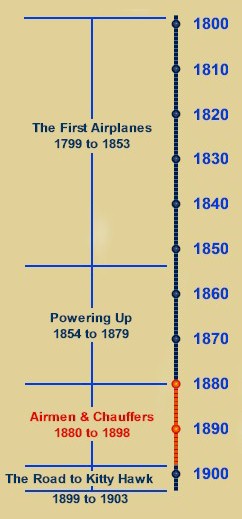
|
Time
|
Event
|
1880-
1890 |
Otto
Lilienthal, an engineer from Germany, tests both flat and cambered wing surfaces
to measure their
lifting capability. With his brother Gustav, the two begin a series
of experiments aimed at gathering the engineering data need
to build a successful glider.
|
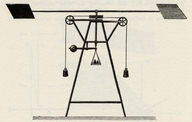
Lilienthal's "whiling arm" apparatus, which he used to
investigate the lift produced by wing shapes, was patterned
after Cayley's 1809 instrument.
|
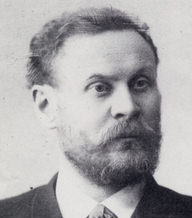
Otto Lilienthal.
|
|
1881 |
Louis
Moulliard, France, writes another milestone in aeronautics, Empire of
the Air, in which he proposes fixed-wing gliders with cambered wings, like
birds. He also proposes that aviators practice in gliders to gain the skill needed to
pilot
an aircraft in the air – they should endeavor to become skilled airmen. Up until that time, everyone in the infant field of aviation
presumed you could navigate the sky with no more skill than a chauffer.
It split the field into two camps, each with a different approach to making a
practical aircraft. The chauffers focus on engineering, making a
stable powered flying machine.
The airmen practice with gliders to gain piloting skills before attempting powered flight.
|
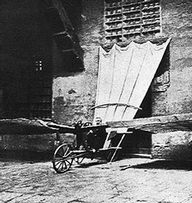
One of Moulliard's semi-successful gliders.
|
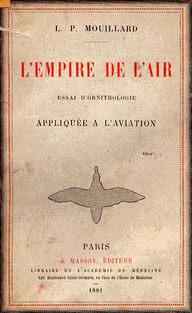
Mouliard's L'Empire de
L'Air.
|
|
1883 |
Siegfried Marcus, a machinist, electrical
engineer, and inventor from Vienna, Austria, patents the
low-tension magneto, the first practical electrical ignition
system for an internal combustion engine.
This improved ignition system enables future gasoline engines to
generate the horsepower, the torque, and especially the speed (RPMs)
required to propel aircraft. This magneto is the most recent
in a long series of improvements he has made to first
primitive electrical ignition system that he installed on
his 1864 engine.
|
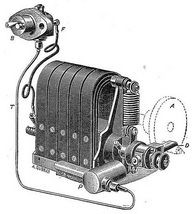
A "low-tension" magneto.
|
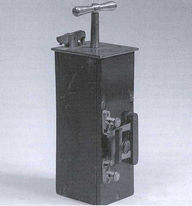
The magneto was developed from another Marcus invention, the
electrical igniter for explosives.
|
|
1884 |
After building and crashing an
unpowered ornithopter (a flapping-wing aircraft) in 1883,
John
J. Montgomery of California switches to fixed-wing aviation. He builds a monoplane glider and
makes the first gliding flight in America.
Alexander
F. Mozhaiski, Russia, builds a steam-powered monoplane and tests
it at Krasnoye Selo, near St. Petersburg. It takes off on a jump ramp and
flies for approximately 100 feet before crashing. This is the second
power-assisted take-off in history.
Horatio
F. Phillips, England, experiments with cambered wings in a wind tunnel
and lays down the scientific foundation for modern airfoil design. He is
the first to discover that when the wind blows across a curved surface, it
creates a low pressure area on top of the surface and high pressure
beneath it. This, in turn, generates lift.
Charles Parsons,
England, invents the steam turbine. Turbines are used first
to generate electricity, then propel ships and boats. But
Parsons' work will eventually lead to the jet aircraft
engine.
|
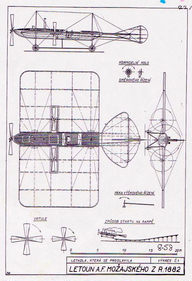
Mozhaiski's aircraft featured propellers embedded in
the wings.
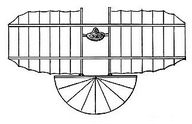
Montgomery's first fixed-wing glider made a brief
flight of about 200 feet (61 meters). |
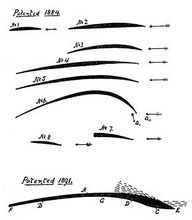
Phillips' sketches of airfoils, showing several of the
cambered wing shapes he tested in his wind tunnels.

Parson's first steam turbine was connected to a small
electric generator.

The turbine blades that Parsons designed were very similar
to cambered wing surfaces.
|
|
1889 |
Octave Chanute,
Illinois, presents two papers on the progress of aeronautical experiments to date.
Lawrence Hargrave,
Australia, builds the first radial airplane engine. It has three cylinders
and runs on compressed
air. Hargrave uses it to power his experimental model aircraft.
March 1 — Orville Wright begins to publish The
West Side News. Wilbur contributes humorous essays, news,
and editorials. Paul Laurence Dunbar contributes poems and essays.
|
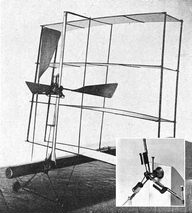
Hargrave's quadraplane was powered by
a 3-cylinder radial motor that ran on compressed air stored in the
fuselage. |
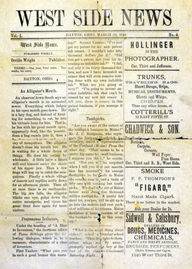
The Wrights' West Side
News.
|
|
1890 |
October 9
— At Chateau d'Armainvilliers in Brie,
France, Clement Ader,
France, flies a bat-wing airplane, the Eolé, for
about 164 feet (50 meters).
The steam-powered, propeller-driven bat-wing craft rises
only 8 inches (20 centimeters) in the air. The flight is
unsustained and Ader has no means
of directional control. Nonetheless, the Eole is the first manned aircraft to
take off from level ground.
|
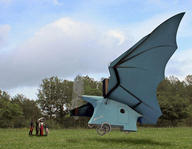
An illustration of Ader's Eole by
Patrick Mallet. The historic aircraft was never as far off the
ground as the artist suggests. |
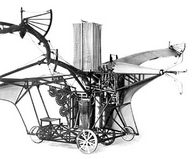
A cutaway replica of the
Eolé.
|
|
1891 |
Otto Lilienthal
begins to test winged gliders, made from cloth stretched over willow frameworks.
Samuel Langley, Virginia,
builds a successful rubber band-powered aircraft he calls an
aerodome. He also begins work on larger steam-and
compressed air-powered models, but the first four do
not meet his aerodynamic expectations and he makes no
attempt to fly them.
October — Octave Chanute begins to publish
articles on aviation in the Railroad and Engineering Journal.
They will later be collected in a single work.
|
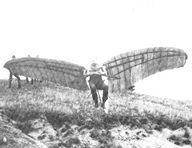
Lilenthal's first successful glider, his "No.
3."
|
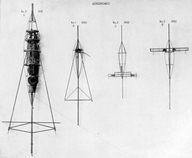
The fuselages of Langley's first four aerodromes
(numbers 0 through 3). These were never tested. |
|
1892 |
Hiram Maxim,
the American-born inventor of the machine gun, builds an enormous
airplane with multiple superposed wings at his English
estate. He uses the rig to measure the lift generated by
different wing configurations as the rig rolls along a
special track. The aircraft rig is not intended for free
flight, instead the track is designed to
capture the aircraft and after it rises a few inches off the rails. Wilbur and Orville Wright purchase "safety
bicycles" and open a sales and repair shop. They give a bicycle to their friend, Paul
Laurence Dunbar.
|

Hiram Maxim's enormous aircraft "test rig" had six
tiers of detachable wings.
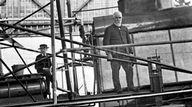
Maxim aboard his test rig.
|
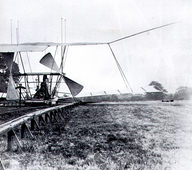
Maxim's test rig rode on a sled along a 1800-foot (550-meter)track. It
had a wingspan of 110 feet (34 meters), was powered by two
180-horsepower steam engines, and weighed 7,000 pounds (3175
kilograms).
|
|
1893 |
Hiram Maxim predicts
that even "under the most unfavorable circumstances, aerial navigation will be an
accomplished fact inside of ten years." Lawrence
Hargrave, Australia, invents the box kite. Because the kite is remarkably
stable and generates large amounts of lift, it creates a sensation in
aeronautical circles, especially among the "chauffers." It's general form influences early airplane
designers. Edward Huffaker suggests that the reason curved
wings produce more lift than flat ones is due to
"Bernoulli's Principle," postulated by Swiss mathematician
Daniel Bernoulli. August 1 through 4 — Octave Chanute organizes the
International Conference on Aerial Navigation at the
World's Columbian Exhibition in Chicago, Illinois.
Wilbur and Orville Wright also come to the
exhibition, but it's doubtful they attended the conference.
November-December —
Samuel Langely attempts to launch Aerodrome No. 4
twice from a catapult mounted on a barge. It fails to
fly on both attempts.
|
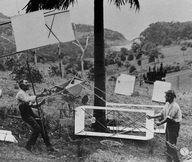
Hargrave measures the tension on a box kite's tether
line. From this, he could deduce how much lift was
generated.
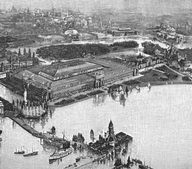
An overview of the World's Colombian Exhibition. Owing to
the advanced agriculture, manufacturing, science, and
technology on display, this is sometimes referred to as
America's "coming-out" party.
|

In 1738, Bernoulli observed that the pressure inside a
stream of fluid or gas
decreases as its speed
increases. Because
the curve of a wing (the camber) causes the air flowing over
the top of a wing to move faster than the air passing
beneath, there is low pressure above the wing and high
pressure beneath it. This difference in pressure is one of
several physical effects that generate lift.
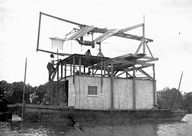
Langely's houseboat/catapult launched the aerodromes over
the Potomac River south of Washington, DC. It was perhaps
the first aircraft carrier.
|
|
1894 |
Augustus Herring buys a glider from Otto
Lilienthal. He then builds two of his own, attempting to improve on
Lilienthal’s design.
Octave Chanute collects his articles on aviation
and publishes them in a book, Progress in Flying Machines. It is the most
complete and well thought-out work on aeronautics to date.
July 31 — Hiram Maxim makes a short,
unintended hop-flight in
his huge airplane when the craft breaks free of its restraining track.
September — Otto Lilienthal
is regularly making successful glides of notable distance
and duration. He flights are the frequent subject of news
stories, and McClure's magazine publishes a nine-page
pictorial of Lilienthal flying several of his gliders. The
article catches the eye of Wilbur and Orville
Wright.
|
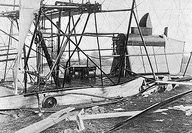
Hiram's wrecked aircraft test rig. Apparently, the upper restraining
rail broke while the craft was traveling about 38 mph (61
kph).
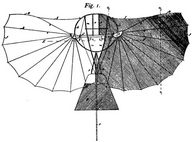
Plans for Lilienthal's "standard" glider.
|
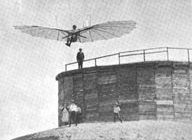
To facilitate his experiments, Lilienthal
built a hill from which he launched his gliders. He named this "Flight Mountain."
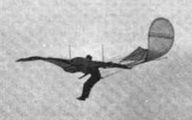
Lilienthal in flight, from the September 1894 edition of
McClure's.
|
|
1895 |
Percy Pilcher,
Scotland, builds a glider, the Bat. He also visits Otto Lilienthal
to ask
advice. He makes Lilienthal's suggested improvements, then flies the Bat
again, but is not satisfied with it. Pilcher builds two more
gliders in quick succession, the Beetle and the Gull, making improvements
based on his own gliding experience.
Edward Huffaker begins to work for Samuel
Langley, designing wings for Langley’s Aerodromes.
Augustus Herring also works briefly for Langley,
doing dynamic tests. Then he moves to Chicago and builds a Lilienthal-type glider for Octave Chanute.
James Means, Massachusetts, begins to
publish the Aeronautical Annual. It will last for 3 years.
William Avery, Illinois, builds a
Chanute-designed multi-wing glider.
William Paul Butusov, a Russian immigrant
living in Illinois,
begins to build
a bird-like aircraft for Chanute. He calls it the Albatross.
|

Pilcher's first gliding machine, the
Bat, after he made
some improvements.
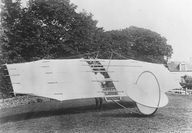
Pilcher's second glider, the Beetle, was heavily built and
hard to handle.
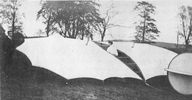
Pilcher's Gull,
his third glider, was too large to fly safely. |
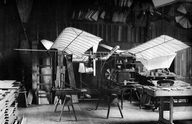
Langley's aeronautical workshop in the Smithsonian
would one day grow to become NACA, and later, NASA.
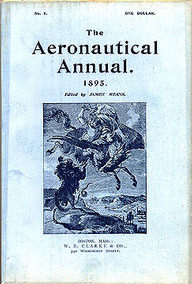
James Means' first
Aeronautical Annual.
|
|
1896 |
Percy Pilcher
builds a much-improved glider, the Hawk, and glides up to 750
feet. Finally satisfied, he plans a powered version.
The Wright brothers begin to manufacture their
own bicycles.
James Means, Massachusetts, writes in the
1896 Aeronautical
Annual that bicycling and flying present similar problems of control and
balance.
May 6 — Samuel Langley
tests a steam-powered model aircraft, Aerodrome No. 5, on the
Potomac. It flies for 3,300 feet.
June 22 — Octave Chanute, Augustus Herring, William
Avery, and others test a copy of a Lilienthal glider and Avery's
multi-wing glider at the Indiana Dunes near Miller, Indiana on Lake Michigan.
August 9 — Otto Lilienthal dies in a glider
crash.
August 21 — Octave Chanute, Augustus Herring, William
Avery, and others test Butusov's
Albatross and a new triplane glider designed by
Chanute and Herring. The performance of the
Albatross is
disappointing and the triplane is difficult to control. But the
experimenters remove a wing to make it a biplane and the glider starts to
perform, eventually making flights up to 359 feet.
October — Upon hearing of Lilienthal’s death, the Wright
brothers deduce correctly that the crash was due to a lack of
control. As experienced cyclists, they understand control
and balance, and are confident they can create an effective
control system for an airplane. They begin a systematic search for literature on aeronautics.
November 28 — Samuel Langley tests another
steam powered aircraft, Aerodrome No. 6. It flies for almost a mile.
|

The Pilcher Hawk about to be launched. It was
controlled in the same manner as Lilienthal gliders. Pilcher kicked his legs to shift his body weight in the direction he
wanted to go.
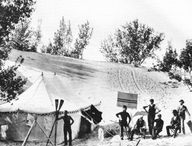
Chanute's camp near Miller, Indiana.
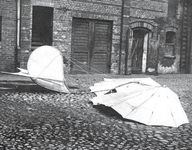
The most likely cause of Lilienthal's fatal crash
was a stall. A gust of wind turned the airplane up and Lilienthal could
not bring the nose down before he lost flying speed.
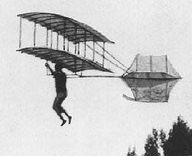
The Chanute-Herring biplane glider was
the best flyer of the 1896 flying season.
|
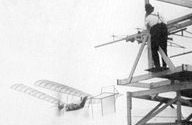
The launch of Aerodrome No. 5. This aircraft and
Aerodrome No. 6 have
14-foot wingspans, making them the largest powered
airplanes ever flown.
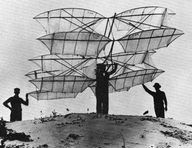
The Chanute multi-wing Katydid was gentle and
stable in the air, but it's performance was disappointing.
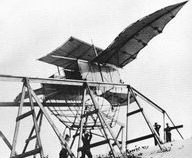
Butusov's Albatross
crashed on its first flight.
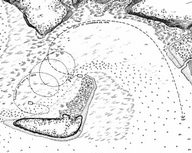
Comparing the flight paths of the May and November 1896
Aerodrome flights.
|
|
1897 |
September — August
Herring tests a biplane glider with a tail of his own design at the Indiana
dunes.
October 12 — Clement Ader, France,
builds another powered airplane, the Avion III, funded
by the French Ministry of War. He attempts to fly the aircraft before
officials, but it never leaves the ground and the War Ministry withdraws its
support. Much later, Ader will try to claim that the aircraft flew
about 1000 feet (304 meters), but the reports filed by the officials in 1897
do not back him up.
|
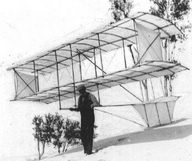
Herring's improved Chanute-Herring glider.
|
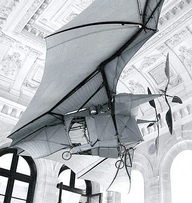
Ader's Avion III at the Musée des
Arts et Métiers in Paris, France.
|
|
1898 |
Samuel Langley,
Virginia, secures $50,000 funding from the War Department to build a man-carrying version
of his Aerodrome by 1899. He hires Charles
Manly as his assistant.
Wilbur Wright observes that buzzards control
their lateral balance by twisting the feathers at the tips of their wings.
Ferdinand Ferber and
Ernest Archdeacon,
France, organizes the Aéro Club de France.
October 11 — August Herring flies about
50 feet (15 meters) in a biplane glider powered by a compressed air engine at St. Joseph, Michigan.
Later, he flies 73 feet (22 meters).
|
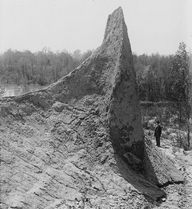
Wilbur rode his bicycle out to a place called the
"Pinnacles" overlooking the Great Miami River. There he
observed turkey vultures or "buzzards."
|
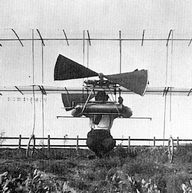
Herring's 4 horsepower compressed air motor did not
give his biplane enough oomph to sustain itself in the air.
|
|
|
|
|